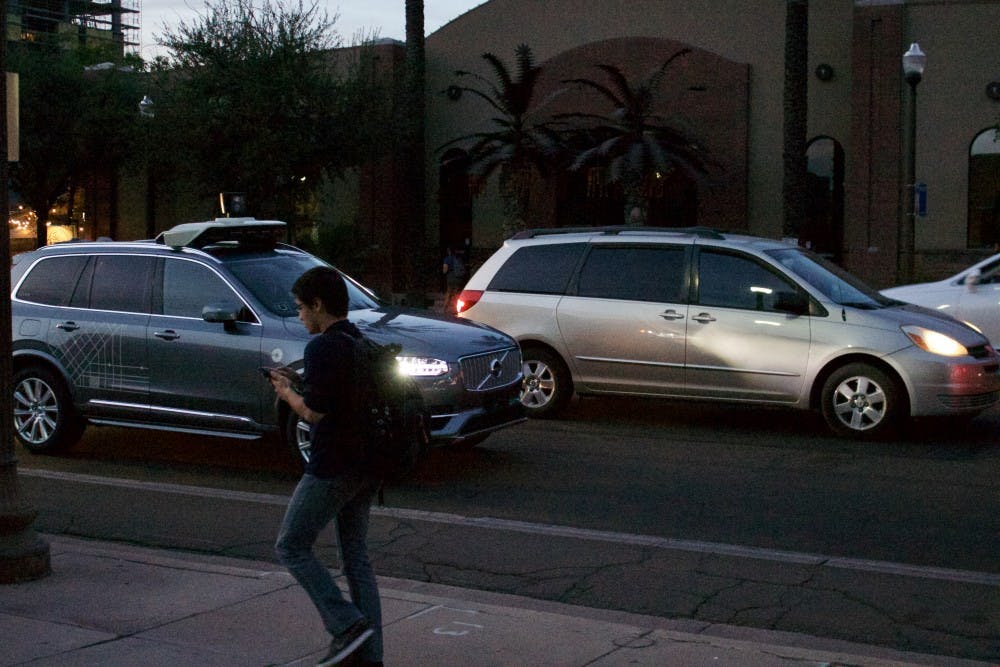Editor’s note: Uber suspended self-driving operations on March 19, 2018, after a self-driving car struck and killed a Tempe pedestrian. Read more here.
Chances are most ASU Tempe students can't walk from their apartments to class without seeing a self-driving Uber, a key part of the ride-share company's plan to “transform the way the world moves.”
Uber has more than 200 cars in its self-driving fleet, and more of those cars are in the Phoenix area than in any other place in the U.S. For Uber, the “ASU loop” is particularly important because it presents challenging driving scenarios that will improve the cars' technology over time.
The loop around the Tempe campus offers “rich data” on how the cars react to obstacles such as distracted drivers, jaywalkers, cyclists and heavy traffic, Uber spokesperson Sarah Abboud said.
“What we want to do with this technology is build a system that can handle all of the crazy things that might happen on the road,” Abboud said.
Uber decided to bring its autonomous fleet to Phoenix in February 2017 after realizing the area presented a unique set of environmental and situational challenges, such as high temperatures and speed limits that weren’t present in Pittsburgh, the first city where the cars were tested.
Support from state government, particularly Gov. Doug Ducey, was also a major factor in bringing the technology to Arizona, Abboud said.
Arizona doesn’t have any special licensing or reporting requirements for self-driving technology. In August 2015, Ducey signed an executive order emphasizing the state’s commitment to supporting self-driving technology. The order stated that “pilot programs will be enabled on campuses of selected universities.” It also established the Arizona Self-Driving Vehicle Oversight Committee to advise the Department of Transportation, Department of Public Safety, universities and other agencies on the technology.
This committee decided it would be best to work with technology companies under existing laws, said Kevin Biesty, deputy director for policy at the Arizona Department of Transportation.
“We really came to the conclusion that these vehicles could operate on our roadways because they’re vehicles, and they need to operate just like any other vehicle,” Biesty said.
Because there is a high number of pedestrians and cyclists around the Tempe campus, the stakes are high for the test vehicles. However, officials said the risk posed by self-driving cars is no higher than that posed by human drivers.
“We’re concerned about a failure in any part of our system, regardless of what the technology is,” Biesty said.
Biesty said ADOT strives for 100 percent safety, but that human decision-making complicates that goal.
“What we’d love to see is zero collisions, zero fatalities,” he said. “Unfortunately, impairment, speeding, inattentive driving has hampered that.”
Biesty said that self-driving technology falls on a spectrum of technologies that ADOT supports to reduce collisions and casualties.
Self-driving Ubers circulate around the Tempe campus for more than 22 hours a day, throughout which time vehicle operators take shifts. As of now, there is always at least one vehicle operator behind the wheel, and sometimes two.
The self-driving Ubers will only pick up riders within a predetermined area. If a potential customer falls in that area, a notification will appear on their phone, at which point they can choose to request a traditional car if preferred.
While Uber is the most visible self-driving car company around the Tempe campus, it’s not the only one. Waymo, a self-driving technology company that is a subsidiary of Google parent Alphabet, Inc., launched its early rider program in Chandler, Tempe, Mesa and Gilbert.
Waymo’s testing is different than Uber’s. Phoenix-area residents can apply to be part of the early rider program, which will give them access to Waymo vans everyday rather than for one or two rides. In turn, early riders with “diverse backgrounds and transportation needs” will provide valuable feedback to the company, according to its website. The program is offered at no cost to users, and can be applied to online.
In addition, the company plans to launch a ridesharing service in the Phoenix area before the end of the year, wrote Waymo spokesperson Amanda Ventura in an email.
“Fully self-driving cars don’t get drunk, tired or distracted and can promise increased independence and mobility for millions of people,” she wrote.
Reach the reporter at maarmst7@asu.edu or follow @MiaAArmstrong on Twitter.
Like State Press on Facebook and follow @statepress on Twitter.




